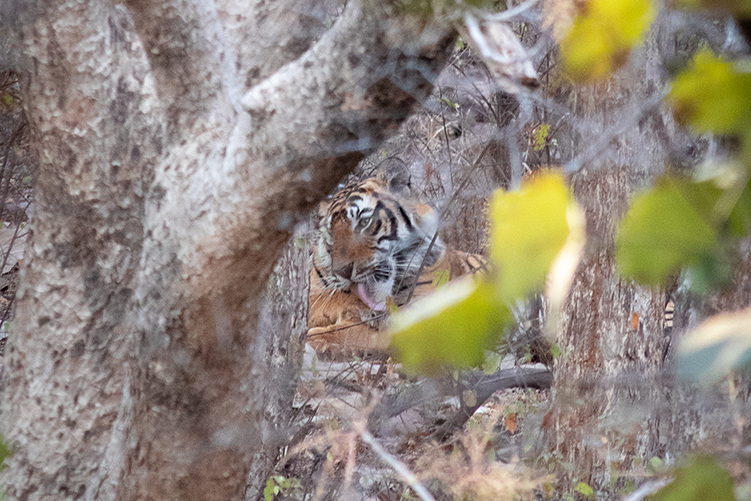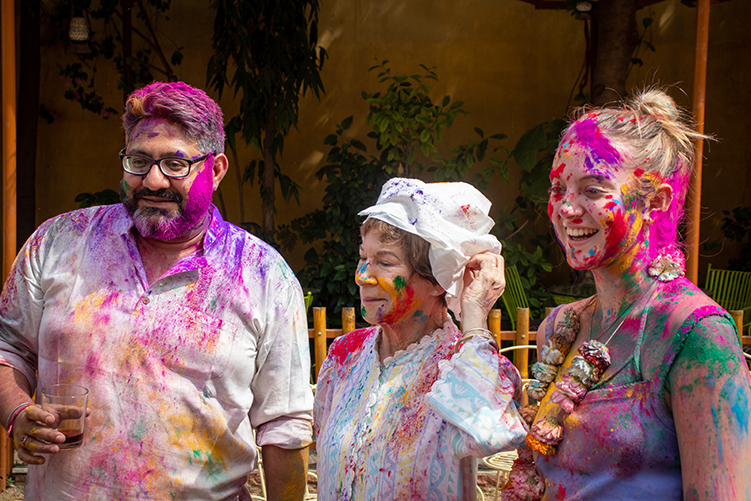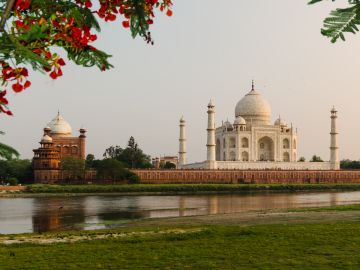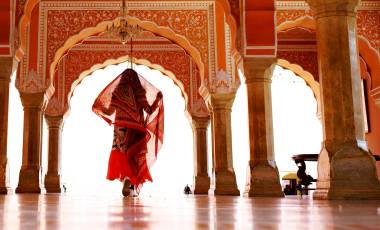Northern India is renowned for its rich cultural heritage, diverse landscapes and architectural marvels. From the iconic Taj Mahal in Agra to Jaipur’s majestic forts and the sacred city of Varanasi, this region offers a treasure trove of experiences for every traveller – and on our Highlights of Northern India trip, you get to see it all! Read on to find out how our very own Graphic Designer, Jack Gamble, got on during his trip, which coincided with the Holi Festival earlier this year.

When asked what his three top highlights of the trip were, Jack said, “It’s hard to choose just three, as it was such a fantastic trip and we managed to pack in so much in nine days, it really felt like an adventure! He continued, “The evening and morning on the Ganges in Varanasi were particularly special as we got to watch an aarti ceremony taking place from the river. The Taj Mahal was also incredible, and we were even lucky enough to see a Bengal tiger in Ranthambore… that’s something I’ll never forget!”
One of the group’s first stops in India was the city of Jaipur. Nicknamed the ‘Pink City’ due to the distinctive terracotta pink hue that adorns most of its buildings, Jaipur was originally painted this colour to welcome the Prince of Wales, Albert Edward, Queen Victoria’s husband, in 1876. The ruler of Jaipur, Maharaja Ram Singh, believed pink to be the colour of hospitality and warmth, and ever since the pink-coloured buildings have been associated with the welcoming nature of the Rajasthani people.

Renowned for its magnificent palaces, forts, and bustling bazaars that offer a glimpse into the opulent lifestyle of past Rajputana rulers, Jack and his group visited the breathtaking City Palace complex and the towering Amber Fort which was built from pink sandstone and white marble. They also saw the impressive Hawa Mahal, known as the “Palace of the Winds,” located in the heart of Jaipur. Built in 1799 by Maharaja Sawai Pratap Singh, this stunning red and pink sandstone palace is renowned for its unique honeycomb-like structure that consists of 953 small windows or ‘jharokhas,’ intricately designed with latticework. Their expert guide, Naveen Bazaz, was keen to share his local knowledge with the group and explained that the main purpose of these windows was to allow former royal ladies to observe everyday life and festivities in Jaipur’s bustling street below without being seen, as they needed to adhere to strict purdah (seclusion) norms in the 18th century.
Naveen also organised a night with an Indian family while they were in Jaipur. Jack said, “In the evening, the head of the family, Mrs Kiran Rathore, did a traditional Indian cooking demonstration. At one point, everyone got involved with making pakora’s which were like fritters mixed with vegetables potatoes, Indian spices and herbs. The family even rated us on our technique! They hosted a beautiful evening and were incredibly welcoming, it was such a nice touch from Naveen.”

Next up on the Highlights of Northern India was a trip to the Ranthambore Tiger Reserve, located in the Sawai Madhopur district of southeastern Rajasthan. Originally established as the Sawai Madhopur Game Sanctuary in 1955, the park was later declared as one of the Project Tiger reserves in 1973, where its main goal is to protect these endangered species. Jack explained, “We went on two successful game drives, where we spotted a Bengal tiger! It was amazing, as soon as we saw it the whole group went completely silent. Even though the tiger was quite far away, those moments watching this 200kg cat prowling around is something I don’t think any of us will forget. As we made our way out of the park, we also were lucky enough to catch sightings of a leopard too – we couldn’t quite believe it!”
While the group where in Ranthambore, the whole country celebrated Holi, a Hindu festival that welcomes springtime and the fresh start of the Hindu calendar month of Phalguna. During this time, Rajasthan cities like Jaipur, Udaipur, and Jodhpur, organise grand processions where beautifully adorned elephants, camels, and horses parade through the streets, accompanied by traditional music and performances that add a royal touch to the Holi festivities. Locals also smear each other with coloured powders and water, symbolising the arrival of spring and the triumph of love and joy. If you travel during this time, you’ll also find delicious Rajasthani delicacies and sweets being sold, including gujiya, malpua, and thandai.

“Although we were in Ranthambore and not near the main cities during the biggest two days of Holi, our guide Naveen made sure we still got the chance to celebrate and organised our very own Holi festival in the hotel’s courtyard with all the staff. We spent the next few hours throwing coloured powder (Gulal) over each other! It was so much fun – we also shared some local spice rum made with herbs and roots, before heading out on another game drive.” Jack was quick to mention that Holi wasn’t just a one-off afternoon event by saying, “Over the course of the week, wherever we went, you could see the locals covered from head to toe in Gulal! Looking back, it was a great time to go and visit the Rajasthan region during Holi – I’d really recommend it.”
“The Taj Mahal was also undoubtedly a highlight for the group. We were up early on day five and we were one of the first tour groups to get through the gates. We spent a few hours there, and Naveen was great at educating us on its history. I’m not going to lie, it was quite busy towards the end, so I’m really glad we got there when we did. There’s something about the Taj Mahal, I can’t quite put my finger on – its presence is quite powerful, yet everyone is quiet, taking it in. After visiting you can understand why it’s one of the modern seven wonders of the world.”

Another top highlight for Jack was the time he spent in Varanasi, one of the holiest cities in India. Situated on the banks of the sacred River Ganges in the state of Uttar Pradesh, Varanasi is believed to be one of the oldest continuously inhabited cities in the world, with an illustrious history that spans over 3,000 years. The city is also considered the spiritual capital of India, where pilgrims from all over the country and the world come to seek spiritual enlightenment and perform religious rituals.
“We arrived on the sleeper train from Agra and headed straight to our hotel. Afterwards, we made our way across the city, weaving through busy streets – to our leader, Naveen’s favourite local restaurant. He ordered us some traditional dishes off the menu which were delicious, before heading to a local lassi shop – where the fruity lassis were topped with malai, rabdi and almonds.”

He continued, “Our group then made it to the riverbank and spent the evening on the Ganges for the Ganga Aarti ceremony which takes place at sunset every day. It was stunning, all the boats on the river were packed into the bank, and everyone watched the choreographed ceremony, while locals were chanting hymns in the background. The following morning, we went back down to the river before sunrise and watched the sun come up on the opposite side to where the ceremony was. People were bathing in the river while the sun came up and the sky was filled with hazy orange and pink hues – it was visually incredible. Although we were in the same place, each boat trip felt entirely different so I’m glad we came back a second time for sunrise.”

On these boat trips, you’ll pass ancient palaces and temples lining the ghats that whisper stories from bygone eras, while the aroma of incense and faint sounds of hymns linger in the air. And despite the bustling energy of the cities, Jack said that some of his favourite moments of the whole trip was the time he spent on the Ganges, because of the intangible sense of tranquillity and calm that somehow swept over every corner of the river.
So, why not join Jack and book an unforgettable trip to uncover the Highlights of Northern India for yourself? Or take a look at our full collection of India adventures here.







